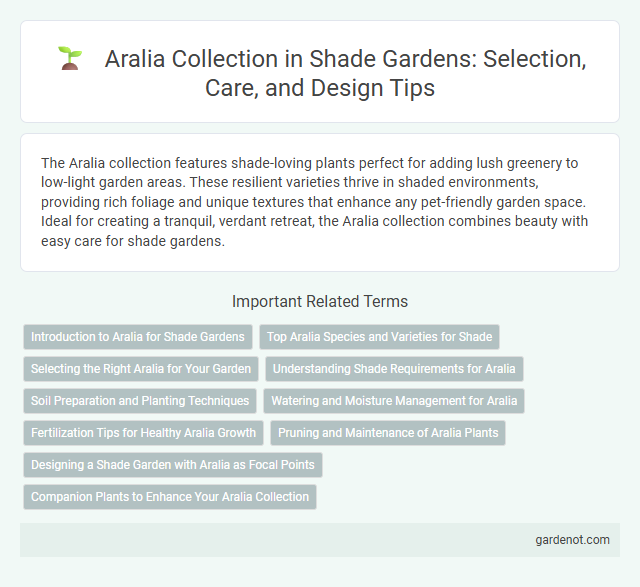The Aralia collection features shade-loving plants perfect for adding lush greenery to low-light garden areas. These resilient varieties thrive in shaded environments, providing rich foliage and unique textures that enhance any pet-friendly garden space. Ideal for creating a tranquil, verdant retreat, the Aralia collection combines beauty with easy care for shade gardens.
Introduction to Aralia for Shade Gardens
Aralia is a versatile perennial well-suited for shade gardens due to its broad, textured foliage and tolerance for low-light conditions. This genus includes species like Aralia cordata and Aralia elata, which thrive in moist, well-drained soil while adding dramatic architectural interest. Incorporating Aralia in shaded landscapes enhances biodiversity and creates a lush, layered understory that supports various pollinators and wildlife.
Top Aralia Species and Varieties for Shade
Top aralia species and varieties for shade gardens include Aralia spinosa, known for its dramatic spiny stems and large compound leaves that thrive in low light conditions. Aralia cordata 'Sun King' offers striking golden foliage, adding vibrant color to shaded areas. Aralia elata, with its elegant upright growth and ability to tolerate dense shade, is a popular choice for creating textured, layered landscapes.
Selecting the Right Aralia for Your Garden
Choosing the right Aralia species for your shade garden depends on your specific climate, soil type, and desired plant size, with popular options including Aralia cordata for its edible shoots and Aralia spinosa for striking spiny stems. Compact varieties like Aralia elata are ideal for smaller spaces, offering dramatic foliage without overwhelming the garden layout. Pay attention to water requirements and growth habits to ensure your selected Aralia thrives in the low-light conditions typical of shade gardens.
Understanding Shade Requirements for Aralia
Aralia plants thrive in partial to full shade, requiring filtered sunlight for optimal growth and vibrant foliage. Understanding the specific shade tolerance of each Aralia species is crucial to prevent leaf scorch and promote healthy development. Maintaining consistent moisture and rich, well-drained soil enhances their ability to adapt to shaded garden environments.
Soil Preparation and Planting Techniques
Aralia thrives in rich, well-draining soil with high organic matter, making compost or aged leaf mold essential for soil preparation in shade gardens. Plant Aralia at the same depth as in its nursery container, spacing each plant 3 to 4 feet apart to ensure adequate air circulation and growth. Consistent moisture retention without waterlogging is crucial, so incorporating mulch around the base maintains soil humidity and temperature for optimal root development.
Watering and Moisture Management for Aralia
Aralia plants thrive in consistently moist, well-drained soil, making regular watering essential to prevent both drought stress and root rot. Maintaining soil moisture without waterlogging involves watering deeply once the top inch of soil feels dry, especially during warmer months, to support healthy growth and vibrant foliage. Utilizing mulch helps retain soil moisture and regulate temperature, creating an ideal microenvironment for Aralia in shade garden settings.
Fertilization Tips for Healthy Aralia Growth
For healthy Aralia growth in shade gardens, use a balanced, slow-release fertilizer with an NPK ratio around 10-10-10 applied every 6 to 8 weeks during the growing season. Incorporate organic compost or well-rotted manure into the soil to improve nutrient retention and soil structure. Maintain consistent moisture without waterlogging to optimize nutrient uptake and promote lush foliage development.
Pruning and Maintenance of Aralia Plants
Pruning Aralia plants in a shade garden involves removing dead or damaged leaves and stems to encourage healthy growth and maintain a compact shape. Regular maintenance includes monitoring for pests like spider mites and scale, while ensuring soil remains consistently moist but well-drained. Proper pruning enhances air circulation, reducing disease risk and promoting vibrant foliage throughout the growing season.
Designing a Shade Garden with Aralia as Focal Points
Aralia plants, with their large, textured leaves and bold architectural form, serve as striking focal points in shade garden designs. These shade-loving perennials thrive in low-light conditions, adding depth and lush greenery to understory layers. Incorporate various Aralia species like Aralia spinosa or Aralia elata to create dynamic, multi-dimensional garden spaces that combine foliage contrast and natural elegance.
Companion Plants to Enhance Your Aralia Collection
Companion plants such as hostas, ferns, and astilbes create a lush, textured backdrop that enhances the tropical appeal of Aralia collections in shade gardens. These shade-loving perennials thrive in similar soil and moisture conditions, ensuring harmonious growth and vibrant foliage contrast. Incorporating flowering companions like hellebores or bleeding hearts introduces seasonal color, enriching the visual impact and biodiversity of your Aralia garden.
Aralia collection Infographic

 gardenot.com
gardenot.com